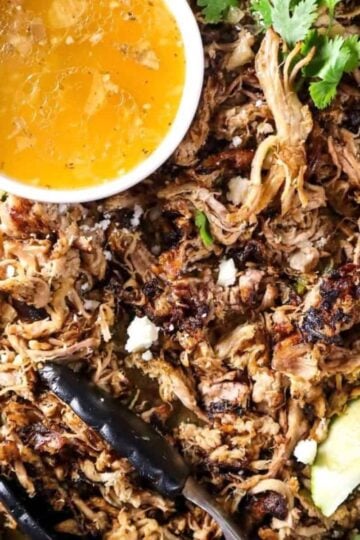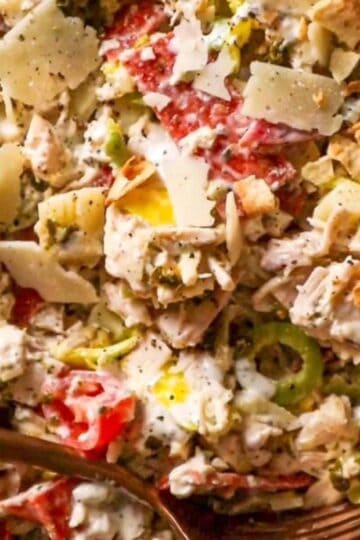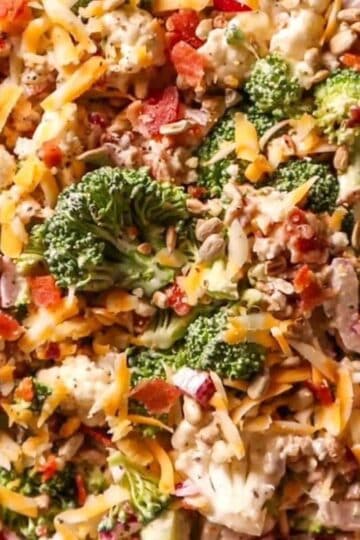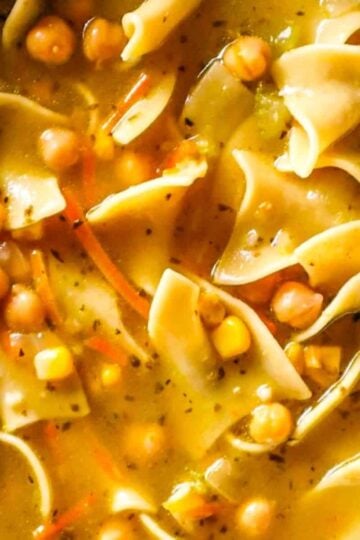Scrambled eggs are a breakfast classic, but making them perfectly fluffy and creamy can be a bit tricky. With the right technique, you can create eggs that are soft, tender, and full of flavor every time. Whether you're a beginner or an experienced cook, this simple step-by-step guide will show you how to make the best scrambled eggs—no rubbery textures here!
Using just a few ingredients—eggs, half & half, and butter—you’ll learn how to achieve the perfect scrambled eggs with a rich, velvety texture. Plus, we’ll cover key tips like avoiding overcooking and getting the right level of creaminess.
Last Updated February 19th, 2025.
What makes these scrambled eggs special?
- Rich & Creamy Texture: Adding half & half and butter keeps the eggs soft and prevents them from drying out, making them extra creamy scrambled eggs.
- Tender & Fluffy: A pinch of kosher salt in the raw eggs helps tenderize them, ensuring a softer, fluffier texture.
- Perfect Temperature Control: Starting at medium-high heat and lowering it as the eggs cook helps create fluffy scrambled egg curds without overcooking.
- The Right Tools Matter: Using a nonstick skillet prevents sticking, while a heat-resistant rubber spatula allows you to scrape the pan cleanly for smooth, perfect scrambled eggs.

Questions to Consider Before You Start:
- What Kind of Eggs Should I Use?
- For the best scrambled eggs, use large, free-range organic eggs—they have vibrant yolks and a richer flavor. However, any fresh eggs will work just fine. For the fluffiest texture, use eggs that are less than three weeks old.
- Storage Tip: Store eggs pointy end down in the carton to keep them fresher longer.
- Does Egg Temperature Matter?
- Yes and no! You can make fluffy scrambled eggs with cold or room temperature eggs, but here’s the difference:
- Cold eggs are easier to separate if you need to remove yolks.
- Room temperature eggs blend more smoothly, helping create creamy scrambled eggs.
- Why Include an Extra Yolk?
- Adding an extra yolk enhances the richness and creaminess of your scrambled eggs, giving them a luxurious, velvety texture.
- What About Mix-Ins?
- Want to add cheese, herbs, or sautéed vegetables? Mix-ins should be added when the egg curds are just beginning to form but are still wet. This allows the eggs to cook around your ingredients, ensuring even distribution without overcooking.

Ingredients:
- Eggs – The base of any scrambled eggs recipe! For the fluffiest and creamiest eggs, use large eggs and add one extra yolk for extra richness. Cold eggs work best when separating the yolks from the whites.
- Half & Half – This creamy addition helps create soft, velvety eggs that aren’t too heavy. Feel free to substitute whole milk or heavy cream if you prefer, but half & half is ideal for the perfect balance of creaminess.
- Kosher Salt – A pinch of kosher salt enhances the flavor of the eggs. Be sure to salt just before cooking to prevent drawing out moisture.
- Freshly Cracked Pepper – Add a sprinkle of freshly cracked black pepper for a touch of heat. This enhances the flavor of the creamy scrambled eggs without overpowering them.
- Chilled Butter – Chilled butter is key to creating the perfect texture. It adds flavor and helps prevent overcooking. Use a nonstick skillet to allow the butter to coat the pan evenly for smooth, fluffy scrambled eggs.
Dietary Restriction & Allergy Friendly Substitutions:
- Dairy-Free Option:
- Swap butter for dairy-free butter or olive oil. Replace half & half with unsweetened almond milk, coconut milk, or oat milk to keep your scrambled eggs creamy without dairy.
- Gluten-Free:
- Scrambled eggs are naturally gluten-free. Just be mindful of any mix-ins like cheese, sauces, or condiments that might contain gluten.
- Egg-Free (Vegan Alternative):
- To make a vegan scrambled eggs recipe, use a plant-based egg substitute like JUST Egg. Cook it the same way for a similar texture.
- Low-Carb/Keto-Friendly:
- This scrambled eggs recipe is naturally keto-friendly! Enjoy it as is, or serve alongside avocado, sautéed spinach, or smoked salmon for a nutrient boost.
- Low-Sodium:
- Skip the kosher salt or use a low-sodium alternative. Enhance flavor with fresh herbs, black pepper, or smoked paprika instead.

Expert Tips for Perfect Scrambled Eggs:
- Skillet Size Matters:
- Using the right pan size helps create a thick layer of eggs for even cooking and fluffy scrambled egg curds.
- 2 eggs → Use an 8-inch nonstick skillet
- 4 eggs → Use a 10-inch nonstick skillet
- Finding the right Temperature:
- Cooking at the right heat is key for soft, creamy scrambled eggs. On an electric stove, use two burners:
- Start on medium-high heat, then switch to a preheated low burner for gentle finishing.
- Perfect Timing for Soft Scrambled Eggs:
- 2 eggs → 30–60 seconds on medium-high, 30 seconds on low
- 4 eggs → 45–75 seconds on medium-high, 30–60 seconds on low
- 6 eggs → 1–2 minutes on medium-high, 30–60 seconds on low
- How to Tell When They’re Done:
- Eggs should look shiny, soft, and hold their shape, but no visible liquid should remain. Slightly undercooking ensures perfect scrambled eggs that don’t turn dry.
- Customizing Texture:
- Want extra creamy eggs? Cook slower and stir less often for larger, softer curds.
- Prefer fluffier eggs? Beat the eggs longer before cooking to incorporate more air.
- Common Mistakes to Avoid:
- Overcooking – Eggs continue cooking after being removed from heat, so take them off slightly underdone for the best creamy scrambled eggs.
- Under-seasoning – Eggs can taste flat without proper seasoning! Salt them before cooking and add a pinch after for the best flavor.
- Cleaning Your Skillet:
- Let your nonstick skillet cool completely before washing to prevent warping and maintain its nonstick surface.

Additional Variations & Mix-In Ideas:
- Cheesy Scrambled Eggs – Stir in shredded cheddar, Gruyère, feta, or goat cheese when the eggs are almost set for extra creamy scrambled eggs.
- Herb-Infused Scrambled Eggs – Add chives, parsley, basil, or dill for a fresh, flavorful twist. Sprinkle them in just before serving.
- Protein-Packed Scrambled Eggs – Mix in cooked bacon, smoked salmon, or diced ham to turn this into a hearty scrambled eggs recipe.
- Veggie Scramble – Sauté spinach, mushrooms, bell peppers, or onions before adding the eggs for a nutrient boost.
- Spicy Scrambled Eggs – Add a dash of hot sauce, chili flakes, or diced jalapeños for a spicy kick.
- Creamier Scrambled Eggs – Stir in a spoonful of sour cream, crème fraîche, or ricotta for ultra-rich and velvety scrambled eggs.
- Breakfast Burrito Scramble – Serve the scrambled eggs in a warm tortilla with avocado, salsa, and cheese for a delicious twist.
- Low-Carb & Keto Variations – Pair scrambled eggs with avocado, smoked salmon, or sautéed greens for a keto-friendly breakfast.

Perfect Scrambled Eggs FAQ's:
- Why are my scrambled eggs rubbery?
- Rubbery eggs are usually overcooked. Eggs continue to cook from residual heat, so remove them from the pan when they’re still slightly soft for the best fluffy scrambled eggs.
- How do I make scrambled eggs creamier?
- For extra creamy scrambled eggs, add an extra yolk, stir in half & half, heavy cream, or a spoonful of sour cream, and cook on low heat while stirring gently.
- Should I use milk or cream in scrambled eggs?
- Half & half or heavy cream creates the richest texture. Milk works, but it produces firmer, less creamy eggs. Avoid adding too much liquid, as it can make eggs watery.
- How do I keep scrambled eggs from sticking?
- Use a nonstick skillet and butter or oil to coat the surface. Stir gently with a heat-resistant rubber spatula to prevent sticking.
- Can I reheat scrambled eggs?
- Yes, but they’re best fresh! To reheat scrambled eggs, warm them gently on low heat in a skillet with a small pat of butter to prevent drying out.
- How do I make scrambled eggs fluffier?
- For fluffy scrambled eggs, beat the eggs longer before cooking to incorporate more air, and use a medium-high to low heat transition while stirring constantly.
- When should I add cheese or mix-ins?
- Add cheese, herbs, or sautéed veggies when the eggs are nearly set but still slightly wet. This ensures they mix in smoothly without making the eggs watery.
- Can I make scrambled eggs ahead of time?
- Yes! While best enjoyed fresh, you can meal prep scrambled eggs by cooking them slightly underdone, then storing them in an airtight container for up to 3 days.
6 Egg-y Recipes You Will Also Love:
- Garlicky Cottage Cheese Scrambled Eggs
- Leaky Cauldron Inspired Egg, Leek, and Mushroom Breakfast Pasty
- Smoked Salmon, Goat Cheese, and Avocado Brunch Salad with Creamy Garlic Dill Dressing
- Southern-Style Breakfast Tater Tots with Sausage Gravy & Eggs
- Pulled Pork Cuban Eggs Benedict with Mustard Cream Sauce
- Classic French Croque Madame Sandwich with Creamy Béchamel
Perfect Your Cooking: More Essential Guides
- Cooking Basics: The Ultimate Guide to Cheese
- The Power of Garlic: Health Benefits and Culinary Uses
- Basic Cooking Measurements & Kitchen Conversion Charts
- A-Z Cooking Terms & Meanings
Tried This Scrambled Egg recipe? I’d love to hear how it turned out! ⭐ Please leave a star rating and review in the recipe card below—your feedback helps others discover this creamy, flavorful dish. Enjoy, and happy cooking! Follow me on Instagram and Pinterest for more delicious recipes, travel inspiration, and behind-the-scenes content.
Recipe

How to Make Perfect Scrambled Eggs
Ingredients
- 4 large eggs + 1 yolk
- 2 tablespoon half & half
- ⅛ teaspoon kosher salt
- Freshly cracked pepper to taste
- ½ tablespoon chilled butter
Instructions
Prep the Eggs
- Crack eggs on a flat surface for a clean break. When separating yolks and whites, use cold eggs to prevent yolk breakage.
- In a mixing bowl (any material is fine), use a fork to gently beat the eggs, half & half, and salt and pepper until combined. Avoid over-beating—large bubbles should just start to form. A fork is gentler than a whisk, which helps preserve the eggs' texture.
Heat the Skillet
- Melt butter in an 8-inch nonstick skillet over medium-high heat. Swirl to coat the pan evenly, but don’t let the butter brown. Butter prevents sticking and adds flavor.
Cook the Eggs
- Pour the egg mixture into the pan.
- Using a heat-resistant rubber spatula, stir constantly, scraping the sides and bottom of the pan to form curds. This promotes even coagulation and prevents overbrowning.
- When curds start to form and the spatula leaves a trail, reduce the heat to low. Gently fold the eggs over themselves until just set, about 30–60 seconds.
Serve
- Transfer eggs to a plate (warm a heat resistant plate in a 200°F oven for an extra touch of luxury).
- Top with fresh cracked pepper and optional herbs for garnish.
Notes
- Large, free-range organic eggs have vibrant yolks and rich flavor, but any fresh eggs will work. Eggs less than three weeks old are ideal.
- Use an appropriately sized skillet to create a thick layer of eggs, ensuring even cooking and large curds.
- 2 servings: 8-inch skillet
- 4 servings: 10-inch skillet
- On an electric stove, use two burners—start on high heat and switch to a preheated low burner for quick temperature adjustments.
- Timing:
- 2 eggs: 30–60 seconds on medium-high, 30 seconds on low
- 4 eggs: 45–75 seconds on medium-high, 30–60 seconds on low
- 6 eggs: 1-2 minutes on medium-high, 30-60 seconds on low
- How to Tell When They’re Done:
- Eggs should be shiny but no visible liquid should remain. The curds should hold their shape without being dry.






Comments
No Comments